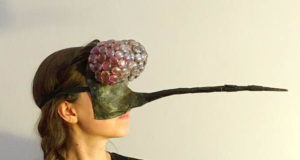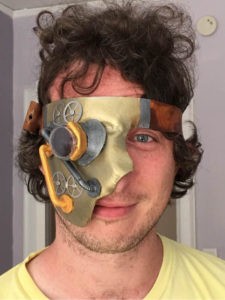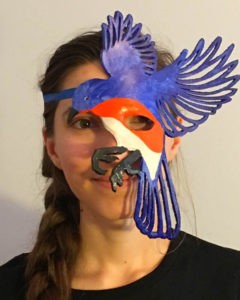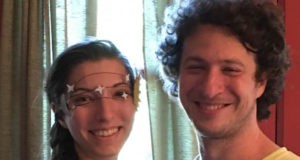
Until a few months ago, I had known Eric only as a performer and as one of the founders of Phoenix. But I was taken by surprise when he answered my Facebook call for tips on conducting a mask-making workshop for children. He kindly agreed to show me some basics at his studio in his then, rather cluttered, studio apartment. When I entered, I was immediately struck by the vibrancy and extraordinary craftsmanship of the 50 or 60 paper and leather theatrical and costume masks that were scattered about.
More recently Eric and his girlfriend, actress Cate Jackson, moved to a spacious new apartment, where the masks very neatly line the shelves and hang from the walls in an orderly fashion. The masks, which are gorgeous, range from the representational
to the allegorical (depicting seasons and mythological figures) to the conceptual and abstract. I particularly liked a rather creepy, industrial-type half-face, which Eric said he designed with an “off-center, sort of diesel-punk aesthetic” in mind.
Eric has studied techniques ranging from Balinese wood carving to Venetian Commedia dell’arte and Carnival masks. While his own masks are influenced by a wealth of cultures he tries not to emulate or “counterfeit” other traditions.
Unless he is working on a commissioned project, “I’m pretty free with it. If I see something that strikes my fancy, I’ll try to make it.”
For instance?
“I saw a bluebird cut out and I decided it could be a mask.”
Cohen was introduced to mask-making during his studies at Dell’Arte International, a well-known circus arts school in California. But the interest in the theater, and more broadly in the performing arts, happened slowly and gradually.
“I got an undergraduate degree in engineering and that was the path – and I was dead certain I was going to do that my whole life. I knew when I was 15 and I was certain when I was 18.”
Eric grew up in Washington, D.C., in a Reform household. “These people were intelligent and educated. My mom’s a lawyer and my father works for the government in bureaucracy and he does recreational mathematics in his spare time,” he said. “And I lived in this household so it made sense for me to go into these things and I enjoyed them.
these things and I enjoyed them.
“So I enrolled in Brown University –as an Engineering major.” And somewhere along the way he started juggling.
It started out as a way to pass the time with a couple of friends. But eventually they got pretty good at it and “we picked up acrobatics” and other circus skills – and formed a troupe – the Lub Dub Circus – and toured New England. But continued his education and got his engineering degree.
“By the time I finished college, I didn’t really want to do it. Performing was what spoke to me. That’s what felt right.”
I asked him if his parents were cool with his decision.
Did he have “The Conversation”? The rite of passage in which young artists sit down with their parents and tell them that they’ve decided to go into – or pursue a career in – the theater. More commonly, the conversation takes place before one graduates college with an Engineering degree.
Eric smiled.
“It didn’t go terribly well,” he said. “But, you know, they certainly have supported it since then.”
So much so that they schedule their visits almost always around his shows, so that they can attend his performances. He’s doing less performing these days and doing more producing. But he is also writing.
“I’ve written a short play based on the story of Dervis Korkut. Korkut was the courageous Muslim librarian who risked his life to smuggle the famous [14th century] Sarajevo Haggadah out of the country before the occupying Nazis could get their hands on it,” Cohen said. This happened at a time when Hitler was amassing Judaica for exhibit in his planned “museum of an extinct race” in Prague. Far more dangerous was Korkut and his wife’s harboring of a Jewish girl [Mira Papo] who they disguised as a Muslim servant. In 1990, Dervis Korkus and his wife were designated by Israel as Righteous Among Nations.
Cohen will be sending the play around to see if it will be produced. In the meantime, he’ll continue to manage the Phoenix some 40-50 hours a week, while still writing and taking commissions for masks. And while still somehow finding times to make masks for himself “as it tickles my fancy” and maybe, on occasion, for one other person.
He showed me a delicate breath of a mask: a handful of tiny stars stung along a few pieces of thin silvery wire that he made for Jackson.
made for Jackson.
As I was leaving Jackson asked if I wanted to know how we met? She was in a production that had hired Cohen to create masks for, and she came to Eric’s studio to get a plaster mold of her face done. To ensure a perfect fit, likes to shape his masks around plaster molds of the performers’ faces.
First you sit in a comfortable chair in Eric’s studio and he wraps your face in paper and paste. And you stay absolutely still for about an hour until it dries, breathing only through the straws in their nostrils.
So face-molds can bring people together. That’s what I’d call showmantic.
This interview was made possible in part with support from the Howard B. & Ruth F. Brin Jewish Arts Endowment, a fund of the Minneapolis Jewish Federation’s Foundation, and Rimon: The Minnesota Jewish Arts Council, an initiative of the Minneapolis Jewish Federation.



